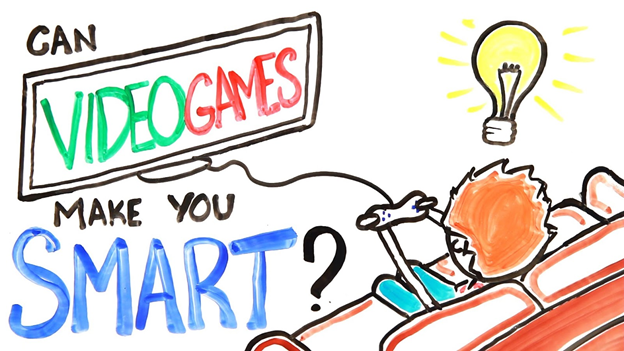Noted psychoanalyst Donald Winnicott famously stated, “It is in playing and only in playing that the individual child or adult is able to be creative and to use the whole personality, and it is only in being creative that the individual discovers the self”(Playing and Reality, 1971).
As students and educators, many of us have experienced the power of play in the classroom. Even a 10-minute game of jeopardy to revise concepts before an exam instantly lifts the vibe in the room. Participation increases manifold, as do processes of peer-to-peer learning.
In this week’s blog post I wish to discuss the following:
1.Why play based pedagogies? How is it connected to learning?
2. Critical considerations when using play/game based pedagogies

(Picture Credit: Asap Science, https://www.youtube.com/watch?v=OOsqkQytHOs&t=29s)
The use of play in an educational context and for purposes of learning and development is often referred to as play or game-based pedagogy. A related concept, though not entirely synonymous, is experiential learning. What these approaches share in common is a shared belief that games offer scenarios within which users make meaningful choices and explore how these choices have
consequences within a game world (Hanghøj, 2013).
As Salter (2015) has described, there could be various places to start our journey of incorporating games into the classroom, ranging from using preexisting games as a case study for analysis to developing a game together in the classroom. Her examples illustrate innovative ways in which instructors in creative writing, history, and communication have incorporated games in the classroom. This blogpost on the CUNY Games network is another resource that gives us an overview of types of games used in the classroom, and their relative pros and cons.
Playing is closely related to creativity (as is self-evident in the gorgeous NetArt project and Michael Barnson Smith’s GIF). It fosters imagination and ideation, which in turn can lead to innovative thinking and improved problems solving (Bateson, 2014). Beyond the output, gaming can help foster the creative process itself. Smale’s Game On for Information Literacy is a great example of the same.
In the previous post, Ming examines the power of games to foster social connections and promote engagement in the classroom. Adding to this list, I wish to describe how games can also teach us how to fail, yes FAIL! Dealing with disappointment, learn from mistakes, and to persevere is a crucial life skill. Games are designed such that for the player failure is always a possibility, although its consequences are not as severe as in real life. Failure in gaming thus creates a constructive learning condition. The player must accept its inevitability and persist till they master the set of tasks necessary to achieve their next goal (Whitton, 2018)
Faculty often discount playing as “childish, frivolous or inauthentic”. As the above discussion and our readings demonstrate, these assumptions are misled. They ignore the ways in which game-based pedagogy promote embodied, social, and creative ways of deep engagement with knowledge. My colleagues in organizing and corporate training spaces are much more appreciative of the value of play in learning. I would love to hear your thoughts on where you think this resistance towards play in higher ed comes from? What does it says about our epistemological assumptions of knowledge? What are existing assumptions of how effective knowledge transmission happens- for whom, under what conditions?
Play based pedagogy: critical considerations.
Previously, we read Bejamin’s (2019) work on systemic bias coded into algorithms and technology. The same can be said of gaming as well. Whether it is motivation driven by extrinsic reward such as collecting money, weapons; survival -of- the- fittest type war games where you must kill your opponent using violent and gory means; or buying your way into extra privileges (and you thought candy crush was innocent, huh?). These are only a few examples of how consciously or unconsciously, gaming replicates neoliberal, patriarchal, White supremacist logics. The upholding of heteronormative assumptions and the sexist representation of female characteristics with extra large breasts or damsels in distress has been quite disturbing for me personally.
The gaming industry itself is fraught with problems. Lack of representation of women, unequal pay, sexual harassment, and toxic work conditions characterized by labor exploitation, layoffs, and poor benefits, are some of the problems facing the industry, according to the Guardian. (Suggested watch – Episode on problems in the gaming industry on The Patriot Act by Hasan Minhaj on Netflix) I would be curious to hear your thoughts on how do we factor in these realities when designing a lesson using games?
Additional Prompts for discussion:
1. In what ways have you encountered “play” in the classroom- both as a student and instructor?
2. Would you like to share any “learning moments” while facilitating play? Moments you felt challenged, awkward, confused, or simple wished you had taken a non-play based route?
3. What are mindful, critical practices of introducing play in the classroom?
References
Benjamin, R. (2019). Race after technology: Abolitionist tools for the new Jim code. Cambridge: Polity.
Hanghøj, T. (2013). Game-based teaching: Practices, roles, and pedagogies. In New pedagogical approaches in game enhanced learning: Curriculum integration (pp. 81-101). IGI global.
Salter A. (2015). Lessons from Teaching with Games. The Chronicle of Higher Education. Accessed online via https://www-chronicle-com.ezproxy.gc.cuny.edu/blogs/profhacker/lessons-from-teaching-with-games
Whitton, N. (2018). Playful learning: tools, techniques, and tactics. Research in Learning Technology, 26.
Winnicott, D. W. (1971). Playing and reality. London: Tavistock Publications


